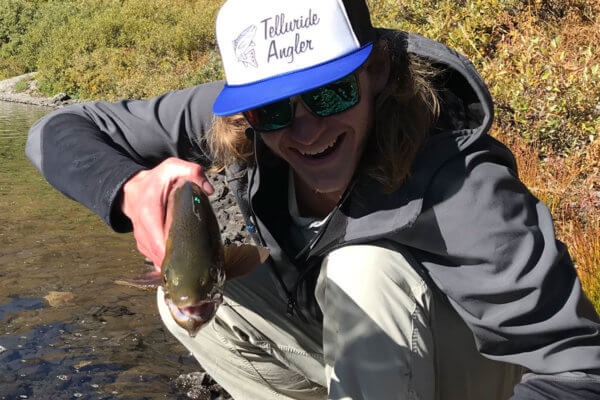
by Parker Thompson
The change of seasons is always an exciting time in the life of an angler, none more so than the transition from winter to summer in the mountains. If you’re like me, you find ways to feed your fishing addiction in the winter months, but nothing rivals a nice sunny day on one’s favorite local creek in the fairer season. When we use the term “creek” we are simply referring to a small body of water or a tributary, found everywhere and generally holding plenty of fish. Simply put, creeking is the most fun you can have with a fly rod. The very nature of creek fishing encourages you to stray from the norm, get off the beaten path, and chase after fish other anglers might overlook. For me, it’s not the fish that make it so much fun, it’s the whole package. It’s the exercise; it’s the seclusion; it’s the laughs. It’s also the ever-present possibility of hooking into an outlier, a “proper trout.” I should note that you may discover many different species of fish in creeks around the world, but for the sake of this article we will be focusing on trout.

When, Where and Why
Know your local fisheries. If you’re looking to explore backyard creeks, do your research first. There isn’t much info online about most small streams. Ask your local shop, but don’t expect them to give away any secrets. Tributaries are special and can take years to figure out. Be patient and remember that every trip is an opportunity to explore and learn. Some creeks are fishable a lot earlier in the summer whereas others that are impacted by runoff may take longer to clear up and come down to a fishable flow. Water clarity, water temperature and water flows all play a big part in determining when your local creek is ready. As noted in the gear section, a portable thermometer can come in handy creek fishing. I carry a stream thermometer and take frequent readings on creeks I fish often. This helps me establish the normal temperature range at a given time of year and corresponding index for what constitutes “too cold” or “too warm.” If you’re hiking and thinking about making your first cast, do a quick temperature check. If still too cold, just keep hiking; the trout aren’t going anywhere.
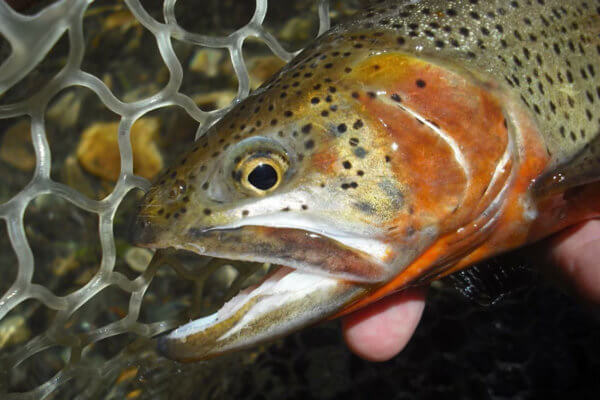 On the other end of things, if you notice that fish are sluggish and not putting up much of a fight, the water may be too warm. As air temperatures climb throughout the summer, so do water temps. It is critical to respect your water and avoid fishing when too warm. In most trout streams, water temperatures above 64 or 65 degrees should draw caution.
On the other end of things, if you notice that fish are sluggish and not putting up much of a fight, the water may be too warm. As air temperatures climb throughout the summer, so do water temps. It is critical to respect your water and avoid fishing when too warm. In most trout streams, water temperatures above 64 or 65 degrees should draw caution.
It is just as important to know your local fish as it is to know your local fisheries. If you’re lucky enough to have low and clear water early in the spring and want to hit the creeks, keep in mind that cutthroat and rainbow trout spawn in the spring. Likewise, if you are fortunate to have adequate water flows in the fall time, that’s when the brookies and browns are spawning. Show those spawning fish respect and fish elsewhere. They are fun to watch but hold your cast!
Gearing Up
Rod/Reel/Line
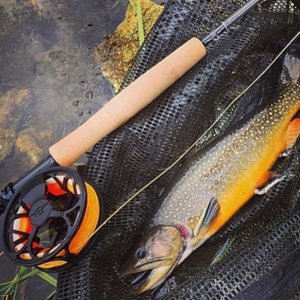 We live in an age with unlimited options. The fly fishing world is similar to the craft beer world in the sense that there are countless options, but not all are right for every situation. Just as you don’t want a full-bodied Imperial Stout on a hot summer day, you don’t want a heavy, long rod on a small creek. It just doesn’t pair well. In general, we like to fish shorter rods in lower line weights on small streams.
We live in an age with unlimited options. The fly fishing world is similar to the craft beer world in the sense that there are countless options, but not all are right for every situation. Just as you don’t want a full-bodied Imperial Stout on a hot summer day, you don’t want a heavy, long rod on a small creek. It just doesn’t pair well. In general, we like to fish shorter rods in lower line weights on small streams.
There are two prominent materials used in creek-specific rods: graphite and fiberglass. Of the two, graphite rods are more popular for the everyday angler looking to cross over into the small ball realm and fiberglass is more popular among dedicated creek anglers. As a material, graphite is much stiffer than fiberglass and therefore graphite rods will handle bigger flies and windier conditions better. Fiberglass, on the other hand, is very durable, but the rods tend to be much slower in action than graphite rods. It really comes down to personal preference, but I should note that fiberglass rods across the board have superior feel over graphite rods and are a lot easier to maneuver in close. I personally love fiberglass rods. They are fun to cast and even more fun to catch fish on.
When it comes to fly reels, you will commonly see two different styles paired with creeking rods. Perhaps the more popular of the two is a click-and-pawl style reel. These reels are typically on the lighter end of things and may not have an adjustable drag system. They are popular because they tend to balance out shorter rods better and are very simple to use. Less is more on the creek. The other option would be a reel with an adjustable drag. These are nice if you plan on targeting larger fish. Perhaps your creek reel will serve double duty on a tailwater, where heavy fish make hot runs on broad water. Both styles will work well, it just comes down to personal preference and whether versatility is a priority. In considering your fly line, it is crucial to pair the line with the rod you will be using. In general, a dry fly style line will be best for creeking, but don’t hesitate to ask your fly shop for a specific recommendation.
What to Wear
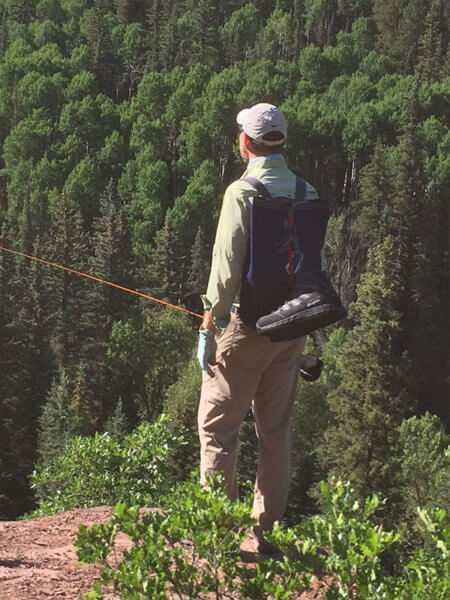 If you’re doing it right, you will likely be hiking long distances during creeking adventures. It is important to prepare accordingly. There are a lot of wading boots on the market today and some are better than others for creeking. Plan on spending long days in your boots with a lot of time on dry land rather than in the water. In general, I recommend a lightweight boot with a good Vibram rubber sole. Felt boots are nice in big rivers with slippery bottoms, but Vibram is the clear winner when it comes to traction on land. Unless you’re fishing on a colder day in the rain, it’s best to leave the waders home. Wet wading is often much more comfortable in the summer months. I like to suggest wearing neoprene wading socks with a pair of lightweight fishing style pants rather than shorts. Shorts can be nice from a temperature standpoint but bushwhacking with bare legs has never been a good idea. Pants will protect your legs from thorns, sunburn and bugs. Consistent with all summertime outdoor activities, sun protection is a must. We recommend long sleeves, a brimmed hat, and plenty of sunscreen. Putting a layer of sunscreen on at the truck before heading out is always a good idea, but you should also have some in your pack for later in the day. Depending on where you’re fishing and what time of year it is, you should also have some sort of insect repellent just in case. There’s nothing worse than cutting a day of fishing short because you are not prepared. Finally, be sure to bring your polarized sunglasses. Various lens colors will suffice, but in general we prefer a copper- based lens for trout. The last thing in terms of clothing that you should never be without is a good rain jacket. You can’t put a price on being warm and dry during a rainstorm. There are a lot of great jackets out there, just make sure you bring one that can easily be carried all day.
If you’re doing it right, you will likely be hiking long distances during creeking adventures. It is important to prepare accordingly. There are a lot of wading boots on the market today and some are better than others for creeking. Plan on spending long days in your boots with a lot of time on dry land rather than in the water. In general, I recommend a lightweight boot with a good Vibram rubber sole. Felt boots are nice in big rivers with slippery bottoms, but Vibram is the clear winner when it comes to traction on land. Unless you’re fishing on a colder day in the rain, it’s best to leave the waders home. Wet wading is often much more comfortable in the summer months. I like to suggest wearing neoprene wading socks with a pair of lightweight fishing style pants rather than shorts. Shorts can be nice from a temperature standpoint but bushwhacking with bare legs has never been a good idea. Pants will protect your legs from thorns, sunburn and bugs. Consistent with all summertime outdoor activities, sun protection is a must. We recommend long sleeves, a brimmed hat, and plenty of sunscreen. Putting a layer of sunscreen on at the truck before heading out is always a good idea, but you should also have some in your pack for later in the day. Depending on where you’re fishing and what time of year it is, you should also have some sort of insect repellent just in case. There’s nothing worse than cutting a day of fishing short because you are not prepared. Finally, be sure to bring your polarized sunglasses. Various lens colors will suffice, but in general we prefer a copper- based lens for trout. The last thing in terms of clothing that you should never be without is a good rain jacket. You can’t put a price on being warm and dry during a rainstorm. There are a lot of great jackets out there, just make sure you bring one that can easily be carried all day.
Packs and what to put in them
When it comes down to choosing the perfect pack, it’s important to remember that everyone has different tastes. The three most popular styles of packs for creeking are lumbar packs, sling packs, and backpacks. Some folks still prefer to use a vest, but with lunch and a rain jacket onboard, something with a little more room will play to your advantage. Lumbar packs are nice because they are relatively light and are pretty comfortable. My one caution with a lumbar pack is space. Of the three pack styles, lumbar packs tend to be the smallest. You want to be able to carry all of your fishing gear plus a jacket, water, and lunch. Sling packs have grown in popularity and are great for creek fishing. They are easy to fish out of but have plenty of room for all the essentials for a long day. The last option is a backpack. This is a great choice for really long days or even small overnight trips. It can be a little challenging to fish out of a backpack, but there are plenty of ways to do it. Consider pairing your backpack with either a lanyard to hang tools and accessories or a small chest pack. Most companies have some sort of integrated system with a backpack and chest pack together.
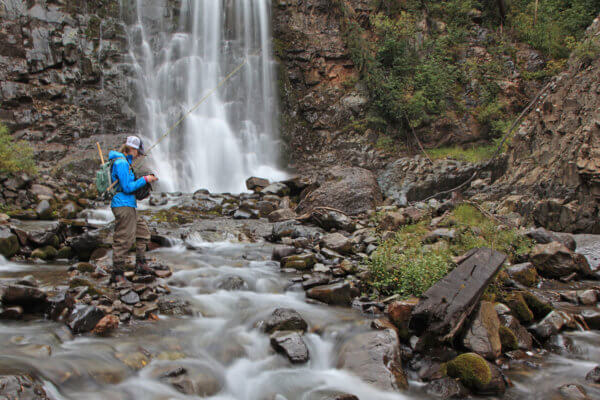 You don’t need a whole lot in terms of flies, tools and accessories in your pack. One box of dry flies is usually plenty for a day on the creek. We’ll touch more on this in the next section, but in general, fly choice is usually not a huge puzzle. Basic tools like nippers and hemostats are essential. Hemos, in particular, can really come in handy when releasing fish. A lot of times the really small fish will hammer a well-presented dry fly and it’s nice to use a tool to take the fly out. As I mentioned earlier, I like to keep a small portable thermometer with me in the name of science. Staying hydrated is also very important. Bringing a water bottle is a good move, but having a small lightweight water filter is always my preferred method. It takes up less room and you have cold water all day. If you plan on being out all day make sure to have a lunch and some snacks with you. Everyone has their favorite fishing snack. Personally, I enjoy Slim Jims and other small snacks loaded with protein. There is a lot of debate about whether or not to bring a landing net while creeking. Most people tend to leave them in the truck as the chances of hooking a fish that necessitates a net are usually pretty slim. Personally, I don’t fish anywhere without at least a small net. It’s easier on the fish and if you have the room, a small lightweight net is always a good call. The last thing that I always make sure to have is some sort of a small first aid kit. There’s no substitute for being prepared when you need to be.
You don’t need a whole lot in terms of flies, tools and accessories in your pack. One box of dry flies is usually plenty for a day on the creek. We’ll touch more on this in the next section, but in general, fly choice is usually not a huge puzzle. Basic tools like nippers and hemostats are essential. Hemos, in particular, can really come in handy when releasing fish. A lot of times the really small fish will hammer a well-presented dry fly and it’s nice to use a tool to take the fly out. As I mentioned earlier, I like to keep a small portable thermometer with me in the name of science. Staying hydrated is also very important. Bringing a water bottle is a good move, but having a small lightweight water filter is always my preferred method. It takes up less room and you have cold water all day. If you plan on being out all day make sure to have a lunch and some snacks with you. Everyone has their favorite fishing snack. Personally, I enjoy Slim Jims and other small snacks loaded with protein. There is a lot of debate about whether or not to bring a landing net while creeking. Most people tend to leave them in the truck as the chances of hooking a fish that necessitates a net are usually pretty slim. Personally, I don’t fish anywhere without at least a small net. It’s easier on the fish and if you have the room, a small lightweight net is always a good call. The last thing that I always make sure to have is some sort of a small first aid kit. There’s no substitute for being prepared when you need to be.
On The Water
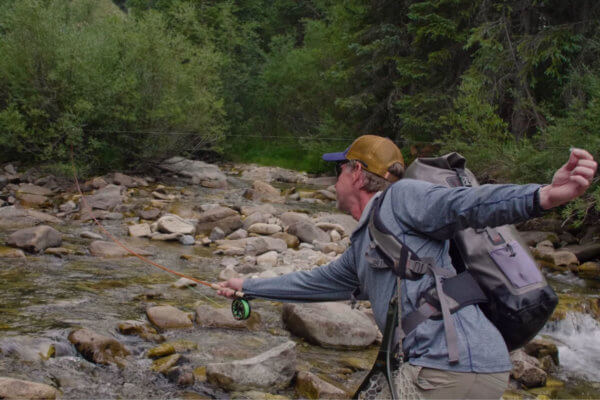 Tributaries in general have prolific bug life. You will see all sorts of insects from really small midges to big hoppers. Though it can be fun to play match the hatch, that’s not usually necessary. We prefer that approach on bigger rivers with more technical fish. Rather, plan on fishing a single terrestrial most of the time. Some folks like to fish a light dry dropper rig, but most of us just leave the nymphs at home and tease the trout to the surface with good presentation.
Tributaries in general have prolific bug life. You will see all sorts of insects from really small midges to big hoppers. Though it can be fun to play match the hatch, that’s not usually necessary. We prefer that approach on bigger rivers with more technical fish. Rather, plan on fishing a single terrestrial most of the time. Some folks like to fish a light dry dropper rig, but most of us just leave the nymphs at home and tease the trout to the surface with good presentation.
Stealth is key. Keep in mind that even though tributaries have fish that some would consider uneducated, those fish can still be very spooky. It is imperative to move with caution and constantly have your eyes on the water. Big fish sometimes like to hang out in skinny water and are not very likely to eat if they have been spooked. Being stealthy will play to your advantage. Pay attention to your shadows and don’t move too abruptly in the water. I like to suggest using a little lighter tippet depending on the water you are fishing. Typically, you will not need the strength of thicker tippet and those smaller rods fish delicate tippet really well. Fishing 5x or 6x can help increase your odds. You should also pay close attention to your surroundings. It’s pretty rare that you have a lot of room for a backcast. Utilizing the roll cast, steeple cast and other techniques will help in situations where you have a lot of obstructions. These techniques help keep flies in the water and out of the bushes.
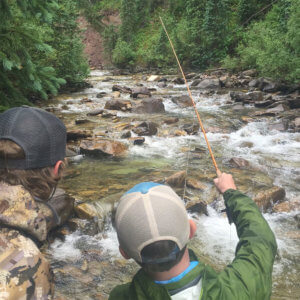 I would highly suggest fishing with one, potentially two close fishing friends. We always say fly fishing is a team sport and never has that been more true than with creek fishing. When fishing with a buddy, it’s fun to either fish one at a time or choose a specific stretch for each of you. Personally, I’m all about playing “the fishing game” with one person fishing at a time. Creek fishing can be downright silly at times in terms of how many fish you catch. Having a fishing friend nearby to share the laughter and good times accentuates the experience.
I would highly suggest fishing with one, potentially two close fishing friends. We always say fly fishing is a team sport and never has that been more true than with creek fishing. When fishing with a buddy, it’s fun to either fish one at a time or choose a specific stretch for each of you. Personally, I’m all about playing “the fishing game” with one person fishing at a time. Creek fishing can be downright silly at times in terms of how many fish you catch. Having a fishing friend nearby to share the laughter and good times accentuates the experience.
It is also a good idea to make sure to cover a lot of ground. Creeks can be loaded with fish, but they are usually spread out. Exploring and hopping from hole to hole is a great way to make sure you don’t miss anything.
Finally, it is essential to remember that fish that aren’t often bothered are much more likely to eat your fly than ones that see a lot of flies. Get out there and explore! Don’t fish right by the trail; hike and get away from anyone else that might be fishing. Have fun out there and keep those flies out of the trees!
A look at my gear
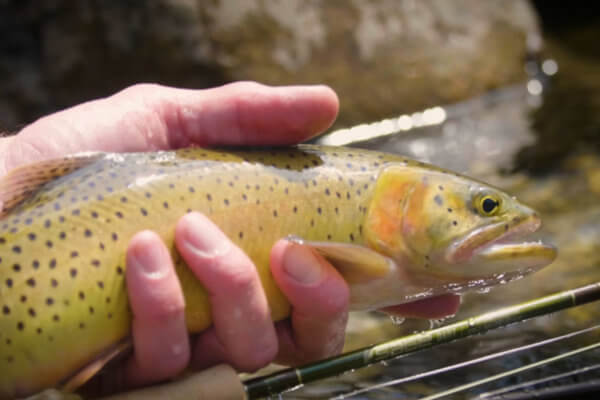 Rod – Scott F Series 622/4
Rod – Scott F Series 622/4
Reel – Abel TR 2/3
Line – SA Amplitude Double Taper DT2F
Leaders – Rio Powerflex + 7.5’ 5x or 6x
Tippet – Rio Powerflex + 5x and 6x
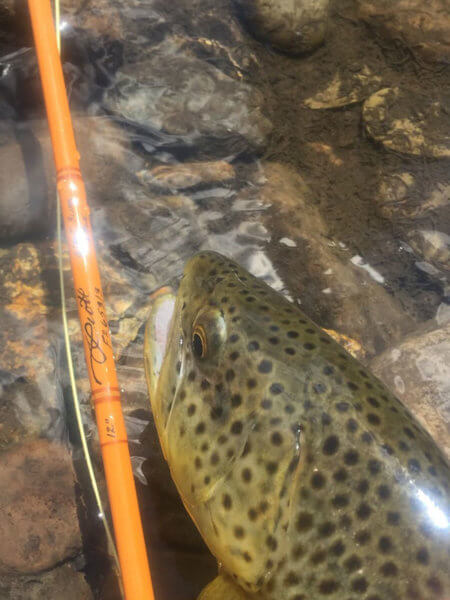 Boots – Simms Flyweight Access (Vibram sole)
Boots – Simms Flyweight Access (Vibram sole)
Pack for longer days – Fishpond Thunderhead Backpack w/ Fishpond Thunderhead Chest Pack
Pack for shorter days – Fishpond Thunderhead Sling
Thermometer – Fishpond Swift Current Thermometer
Net – Fishpond Native Net
Note: You can never have enough dry shake! If the fishing is good, you’ll be using it non-stop.
Some of our favorite outfits
Scott custom “Small Game” G 802-3 with Abel TR 2/3 “Wilson Peak” edition and SA Amplitude Trout Standard WF2F
Scott F Series 663/4 with Galvan Brookie 2-3 and SA Amplitude Double Taper DT3F
Sage DART 376/3 with Sage Click 3/4/5 and Rio Creek WF3F
Winston PURE 7’6” 3wt with Abel TR 2/3 and SA Amplitude Smooth Trout
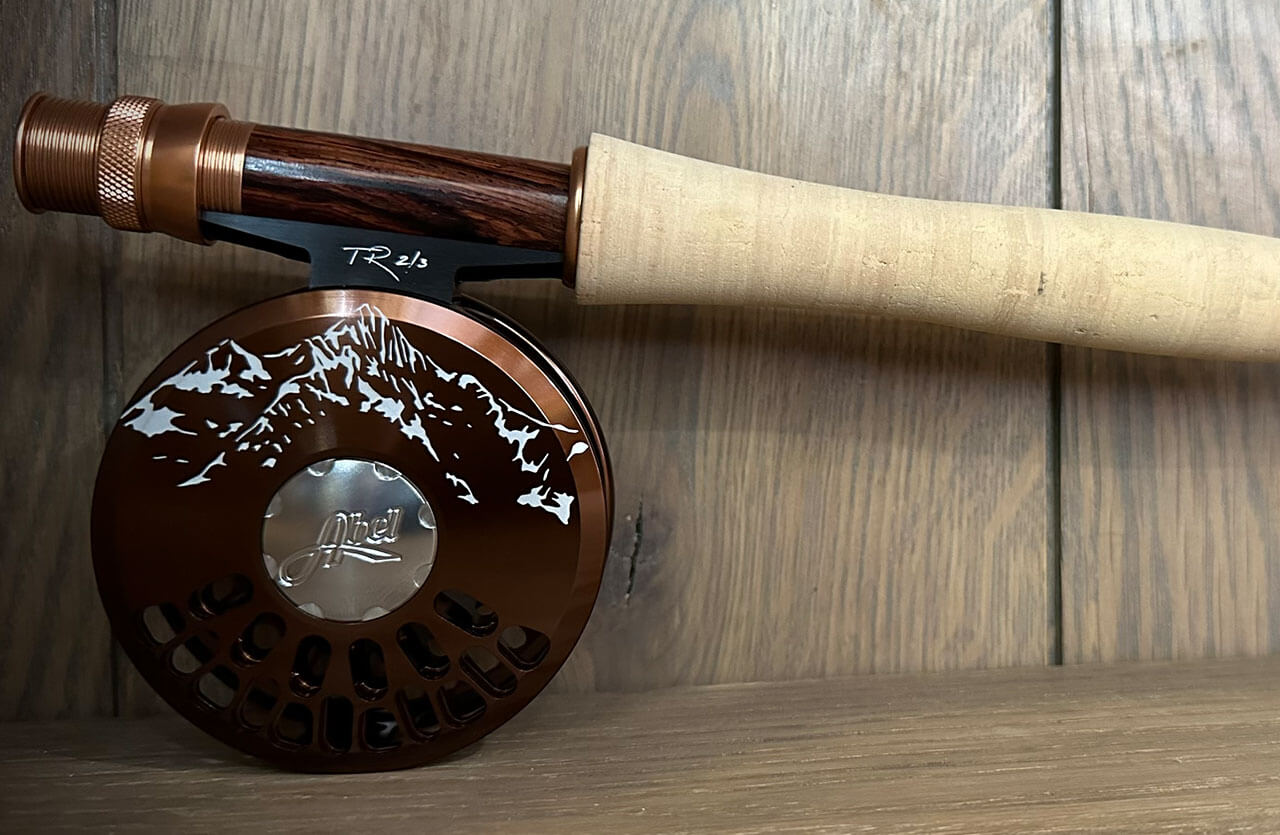
Very good info. Something I’m always in need of.
Thanks for the note, Norman. We’re always happy to share. Have fun out there on the water!
Excellent article and I am ready to play on small creeks in the White Mountains of Arizona the end of April. Actually, after reading the article ready to go NOW! Thanks, howie
Howie,
Thanks for saying so, it was a fun one to write! Have fun out there and enjoy. Give us a shout if you have any questions on this or anything else.
Great article I have really gotten into fishing the smaller creeks in the past few years! I had a question regarding this statement from the article ” If you’re hiking and thinking about making your first cast, do a quick temperature check. If still too cold, just keep hiking; the trout aren’t going anywhere.”
What temperature is considered too cold and what does it do to the trout? and by keep hiking I would assume keep heading up in elevation but then isnt it going to be colder the farther up you go? appreciate you feedback !
Which short, light rods tend to “bow and arrow” and roll cast best? Glass or graphite?
Eddie,
Thanks for reaching out. For the Bow and Arrow cast the fiberglass rods are the clear winner. It takes a little while to get used to the method but once you get the hang of it you’re sure to make those tricky casts! Have fun out on the water and please let us know if we can help with anything else in the future.